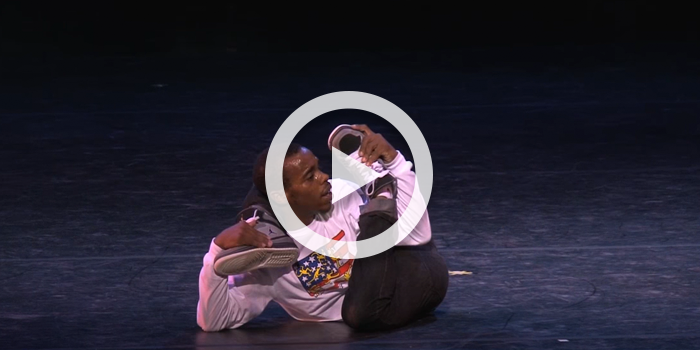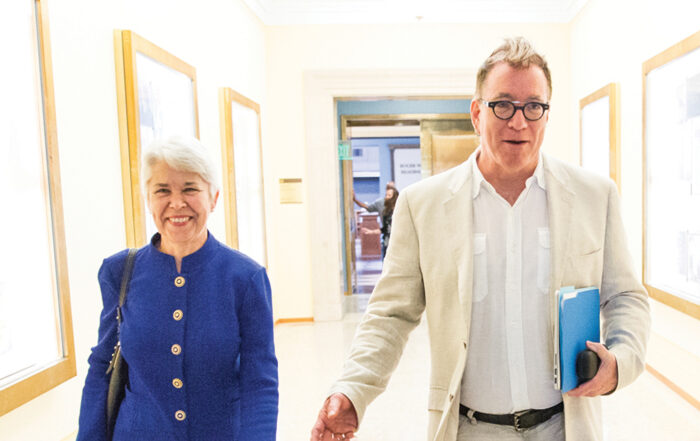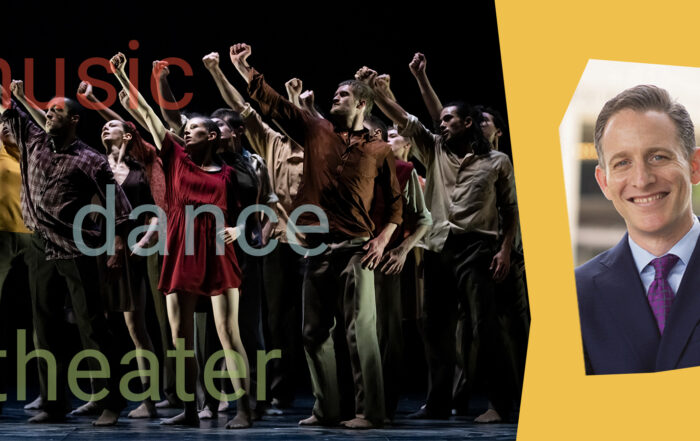Celebrating Black History Month with Mozart’s “Durch Zärtlichkeit und Schmeicheln” performed by Reri Grist; Excerpt from Im schwarzen Rössl performed by Katherine Dunham; Balm in Gilead performed by Alicia Graf Mack and choreographed by Arthur Mitchell; Coltrane’s “Alabama” performed by John Coltrane; Richard Smallwood’s “Total Praise” performed by Richard Smallwood and Vision; “Life Lines” performed by Flutronix with Joe Blaxx; Emancipation of Expressionism performed by Boy Blue and choreographed by Kenrick “H20” Sandy
Now, More Than Ever: Issue 54
The impetus behind Black History Month, our country’s annual recognition of the accomplishments of African Americans and their central role in US history, dates back to 1926, when a host of influential Black leaders began to advocate for the regular setting-aside of one week each year for the celebration of Black history. Four decades later, in 1969, a month-long approach was proposed by educators and students at Kent State University. The idea soon caught fire and since 1976 with Gerald Ford, every US president has officially designated February as Black History Month. Today, the commemoration has spread internationally, with countries including Canada, Great Britain, Ireland, and the Netherlands also devoting time on the calendar (although not always in February) to honoring Black history.
Certainly, no discussion of the immense contributions of Black artists can be limited to the four weeks of February. Such a sprawling topic—one that covers so much rich and illuminating history—quickly defeats the constraints of a month-long celebration. But Black History Month does offer a powerful opportunity to focus hearts and minds; that being the case, let’s dedicate today’s Now, More Than Ever to some extraordinary Black performers and creators, past and present.
Mozart: “Durch Zärtlichkeit und Schmeicheln” from Die Entführung aus dem Serail
Reri Grist, soprano
Orchestra of the Bavarian State Opera
Karl Böhm, conductor
Now approaching her 89th birthday, soprano Reri Grist introduced the world to Leonard Bernstein’s timeless song “Somewhere” in 1957, as a member of the original Broadway cast of West Side Story. Her brilliant international operatic career began in earnest two years later and extended into the 1990s. Here (as she was nearing the age of 50, and probably a good 20 years after other sopranos would have given up this notoriously high-flying role), the famed coloratura is at the top of her game, performing Blondchen’s charming Act II-opening aria from The Abduction from the Seraglio, in which the spirited young lady makes it very, very clear, that she will not be ordered around!
With tenderness and coaxing,
kindness and pleasantries,
it’s easy to conquer
a gentle maiden’s heart.
But surly commands,
bluster, abuse, and scolding
will very quickly banish
both love and faithfulness.
Excerpt from Im schwarzen Rössl
Katherine Dunham, dancer and vocalist
The extraordinary careers of Katherine Dunham and Arthur Mitchell—both of whom have featured in earlier issues of NMTE, Dunham in Issue 22 and Mitchell in Issue 20—were as alike as they were different, but what impresses me most is that each of these artists had the courage and strength of character to leave behind international careers of almost unimaginable success and refocus their energies on the work of building communities and creating opportunities for others—Dunham through her Katherine Dunham Centers for the Arts and Humanities (KDCAH) in East St. Louis, IL, and Mitchell with his legendary Dance Theatre of Harlem (DTH).
As Dunham’s official KDCAH biography reads:
[She] revolutionized American dance in the 1930s by going to the roots of Black dance and rituals, transforming them into significant artistic choreography that speaks to all. She was a pioneer in the use of folk and ethnic choreography and one of the founders of the anthropological dance movement. She showed the world that African-American heritage is beautiful.
This captivating—if, to our modern eyes, somewhat dated—performance from the 1961 Austrian film Im schwarzen Rössl will give you some idea of the international scope of Dunham’s appeal as well as her incandescent star quality. (I get a kick out of the sober, motionless, perhaps slightly perplexed Austrian audience!) And in this terrific outtake from the Dunham tribute at the 1983 Kennedy Center Honors, the artist displays true joy in watching young people breakdance on a stage that, at the time, had yet to embrace it as a “serious” form of dance.
Balm in Gilead
Alicia Graf Mack, dancer
Arthur Mitchell, choreographer
Here, dancer Alicia Graf Mack, formerly of the Alvin Ailey American Dance Theater and Dance Theatre of Harlem and now director of Juilliard’s Dance Division, offers a stirring tribute to Arthur Mitchell, the groundbreaking dancer, choreographer, artistic director, and educator. Mack’s sublime performance of Mitchell’s Balm in Gilead was filmed at the Arthur Mitchell Memorial in December 2018. Set to a recording of Jessye Norman singing a traditional African-American spiritual with an uncredited choir, it’s a powerful example of a new generation carrying Mitchell’s legacy into the future. I’m also very impressed by this interview with Mitchell, in which he discusses “the fallacy of Blacks and ballet.”
In an appreciation of Mitchell published in Dance Magazine, Theresa Ruth Howard, a former DTH member, wrote, “He almost single-handedly inspired and gave opportunities to thousands of ballet dancers of color, showing the world that indeed, ‘Yes we can’ and just as well—if not better than most—and with a little Harlem flair.”
Coltrane: “Alabama”
John Coltrane, tenor saxophone
McCoy Tyner, piano
Jimmy Garrison, double bass
Elvin Jones, drums
Composed by John Coltrane in response to the September 1963 bombing of Birmingham, Alabama’s 16th Street Baptist Church—a tragedy in which four young Black girls were murdered by the Ku Klux Klan—“Alabama” is as dark, wrenching, and powerful today as on the day it was first performed. Coltrane was inspired by and patterned the song on a speech that Martin Luther King, Jr. delivered in the church three days after the bombing. “Like the speech, ‘Alabama’ shifts its tone from one of mourning to one of renewed determination for the struggle against racially motivated crimes” (Jazziz).
Richard Smallwood: “Total Praise”
Richard Smallwood and Vision
(If this video doesn’t begin at 2:18, please reset it.)
This might not be the most polished version of Richard Smallwood’s phenomenally popular “Total Praise,” but it certainly packs a punch and I love that it’s led from the piano by the multi-Grammy-nominated writer and performer. The piece turns up often in concert and church settings, but if many know of Smallwood’s success, fewer are aware of his past troubles. According to the Washington Post:
He wrote [“Total Praise”] when his mother had begun struggling with dementia and a family friend was dying of cancer, leaving Smallwood to serve as a caregiver at times for both.
The song came in a dream, Smallwood says, which is why he now keeps an audio recorder next to his bed.
“I felt left by God,” he says. “I was trying to write a pity-party song, but God pulled me to do a praise song. God said, ‘I want your praise no matter what the situation you are in, good or bad.’ It’s about trusting Him.”
I find it moving that the long tradition of African-American spirituals, gospel, and inspirational music continues to evolve to this day.
“Life Lines”
Flutronix (Nathalie Joachim and Allison Loggins-Hull, flutes)
with Joe Blaxx, drums
We turn our attention now to more contemporary Black performers and composers. Cal Performances at Home followers will recognize Nathalie Joachim from her fall 2020 streamed performance of Fanm d’Ayiti (Women of Haiti), Joachim’s suite of original compositions and arrangements that explore her Haitian heritage and celebrate the songs and stories of Haiti’s most compelling female artists. So, it’s a treat to encounter her in another incarnation, joining partner Allison Loggins-Hull as Flutronix, an urban-pop duo that, since 2009, has been “redefining the flute and modernizing its sound by hauling it squarely into the world of popular music” (MTV).
Less about classical music, but much more linked with electronic music—or at least new music in any guise it assumes—Flutronix’s performances find two leading artists of our generation busy building bridges. The duo’s music dazzles through its broad points of reference and is as plugged into the vernacular as to established art.
Emancipation of Expressionism
Boy Blue
Kenrick “H20” Sandy, choreography
Danny Boyle, director
(If this video doesn’t begin at 3:23, please reset it.)
Popping, locking, waacking, breaking, and krumping—all specialist hip-hop and street dance styles—explode off the stage in Boy Blue’s ecstatic, galvanizing Emancipation of Expressionism.
The East London hip-hop company’s thrilling production—created by choreographer Kenrick “H20” Sandy and filmed by A-list, Oscar-winning director Danny Boyle—showcases “the astonishing technical and performative skill of [its] youthful cast. Sleek, super-synchronized and superbly disciplined, they wind themselves into tense knots and explode in stuttering steps that pinpoint every beat, bodies strafed by lights and smoke” (The Guardian, London).
Inspiringly, the piece was adopted as part of the UK’s General Certificate of Secondary Education (GCSE) curriculum, an academic qualification in a particular subject pursued by students throughout the country. Said Boy Blue Entertainment composer Michael “Mikey J” Asante: “When hip-hop started in the Bronx, it was there as a form of self-expression, so it’s amazing to be at the forefront of bringing the dance form into the UK education system. It’s our job to keep the authenticity, which is why we’re so excited to be making this film.”
Boy Blue was originally scheduled to perform as part of Cal Performances’ live, on-stage spring season this year. We were terribly disappointed when the current pandemic forced the cancellation of the company’s visit and hope to arrange a future residency at Zellerbach Hall once we return to in-person, live-performance presentations.
Now, More Than Ever Full Playlist
Now, More Than Ever Spotify Playlist








